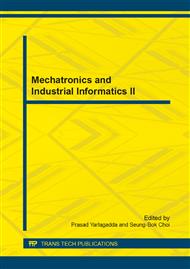p.528
p.532
p.536
p.540
p.547
p.552
p.560
p.565
p.572
Application of the Flexible Brake on Wind Driven Generator
Abstract:
The brake of the wind driven generator requires a gentle process. Which decreases the damage to equipment. In this paper, the flexible brake which can be realized a gentle braking is described. The application on the flexible brake of the wind driven generator are analyzed and explained. Brake is a MCU (Microprogrammed Control Unit) as the core. By the principle of the brake gently, flexible brake has been achieved by the principle of smooth braking. Based on the principle of pulse width modulation of the throttle valve, a safe and reliable braking force has been realized with hydraulic devices and electronic components. MCU controls relay to achieve PWM (pulse width modulation), and monitor the temperature and brake frequency monitoring and so on.
Info:
Periodical:
Pages:
547-551
Citation:
Online since:
July 2014
Authors:
Keywords:
Price:
Сopyright:
© 2014 Trans Tech Publications Ltd. All Rights Reserved
Share:
Citation:


